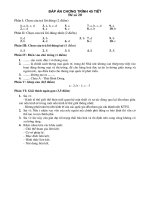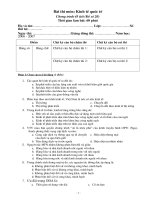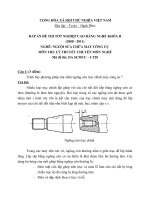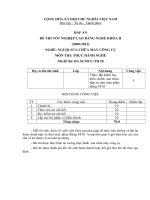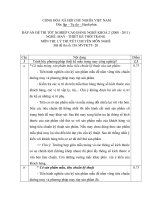PASSAGE 20
Bạn đang xem bản rút gọn của tài liệu. Xem và tải ngay bản đầy đủ của tài liệu tại đây (41.38 KB, 3 trang )
PASSAGE 20
The work of women has been economically vital since prehistory, although their contributions have
varied according to the structure, needs, customs, and attitudes of society.
In prehistoric times, women and men participated almost equally in hunting and gathering activities
to obtain food. With the development of agricultural communities, women’s work revolved more around
the home. As urban centres developed, women sold or traded goods in the marketplace.
From ancient to modern times, four generalizations can be made about women's paid work. Women
have worked because of economic necessity; poor women in particular worked outside the home whether
they were unmarried or married, and especially if their husbands were unable to sustain the family solely
through their own work. Women’s indentured work has often been similar to their work at home. Women
have maintained the primary responsibility for raising children, regardless of their paid work. Women
have historically been paid less than men and have been allocated lower-status work.
Some major changes are now occurring in industrial nations, including the steadily increasing
proportion of women in the labor force; decreasing family responsibilities (due to both smaller family size
and technological innovation in the home); higher levels of education for women; and more middle and
upper-income women working for pay or for job satisfaction. Statistically, they have not yet achieved
parity of pay or senior appointments in the workplace in any nation.
Artisans working in their own homes not infrequently used the labor of their families. This custom
was so prevalent during the Middle Ages, craft guilds of the period, including some that otherwise
excluded women, often admitted to membership the widows of guild members, providing they met
professional requirements. Dressmaking and lacemaking guilds were composed exclusively of women.
Gradually, the guilds were replaced by the putting-out system, whereby tools and materials were
distributed to workers by merchants; the workers then produced articles on a piecework basis in their
homes. During the 18th and early 19th centuries, as the Industrial Revolution developed, the putting-out
system slowly declined. Goods that had been produced by hand in the home were manufactured by
machine under the factory system. Women competed more with men for some jobs, but were concentrated
primarily in textile mills and clothing factories. Manufacturers often favored women employees because
of relevant skills and lower wages, and also because early trade union organization tended to occur first
among men. Employees in sweatshops were also preponderantly women. The result was to
institutionalize systems of low pay, poor working conditions, long hours, and other abuses, which along
with child labor presented some of the worst examples of worker exploitation in early industrial
capitalism. Minimum wage legislation and other protective laws, when introduced, concentrated
particularly on the alleviation of these abuses of working women.
Women workers in business and the professions, the so-called white-collar occupations, suffered
less from poor conditions of work and exploitative labor, but were denied equality of pay and opportunity.
The growing use of the typewriter and the telephone after the 1870s created two new employment niches
for women, as typists and telephonists, but in both fields the result was again to institutionalize a
permanent category of low-paid, low-status women’s work.
Question 1. When the the farming communities developed, women worked _____.
A. less at home
B. more at home
C. more outside
D. in groups
Question 2. With the development of urban centres, women ____.
A. traded cattle in the marketplace
B. stayed at home to take care of their children
Page 1
C. worked more in the marketplace
D. sold cloth in the marketplace
Question 3. The word “indentured” in this context may mostly means _____.
A. outside the home
B. in the kitchen
C. outside the kitchen
D. inside the home
Question 4. With better education and less family burden, women _____.
A. have been respected at home and in the workplace
B. have enjoyed equal status in the workplace
C. have not yet achieved high status in the workplace
D. have become more influential in their companies
Question 5. Although women cannot avoid the task of bringing up children, _____.
A. they have to work to feed their men
B. they have to amuse their men
C. are the mainstay of their families
D. they can be breadwinners as men
Question 6. The word “sweatshops” suggests _____.
A. workshop
B. factory work
C. hard work
D. harmful work
Question 7. During the time of Industrial Revolution, women were dominant in _____.
A. sex industry
B. Broidery
C. textile industry
D. bakery
Question 8. What women have done for the economic development have changed over time due to
_____.
A. their role in the home
B. their marital status and their husbands
C. the different factors of the society
D. the Industrial Revolution
Page 2
ĐÁP ÁN
1-B
2-C
3-A
6-C
7-C
8-C
4-C
5-D
LỜI GIẢI CHI TIẾT
Question 1:
Thông tin nằm ở đoạn 2: “With the development of agricultural communities, women’s work revolved
more around the home.”
Question 2:
Thông tin nằm ở câu cuối đoạn 2: “As urban centres developed, women sold or traded goods in the
marketplace.” (bán hoặc trao đổi hàng hóa ở chợ)
Question 3:
Thông tin nằm ở đoạn 3: “Women’s indentured work has often been similar to their work at home.”
- indentured work = work outside the home
Question 4:
Thông tin nằm ở đoạn 4: “Some major changes are now occurring in industrial nations,…; decreasing
family responsibilities (due to both smaller family size and technological innovation in the home); higher
levels of education for women; and more middle and upper-income women working for pay or for job
satisfaction. Statistically, they have not yet achieved parity of pay or senior appointments in the
workplace in any nation.”
- dù giảm trách nhiệm với gia đình và nâng cao về giáo dục,… họ vẫn chưa nhận được sự ngang bằng hay
những vị trí cơng việc cao hơn ở nơi làm việc.
Question 5:
Thông tin nằm ở đoạn 3: “Women have worked because of economic necessity; poor women in particular
worked outside the home whether they were unmarried or married, and especially if their husbands were
unable to sustain the family solely through their own work.” – phụ nữ phải làm vì sự cần thiết về kinh tế,
nếu như chồng của họ không thể 1 mình làm trụ cột gia đình.
Question 6:
sweatshops: xí nghiệp bóc lột công nhân tàn tệ
Question 7:
Thông tin nằm ở đoạn 7: “…the Industrial Revolution developed, the putting-out system slowly declined.
Goods that had been produced by hand in the home were manufactured by machine under the factory
system. Women competed more with men for some jobs, but were concentrated primarily in textile mills
and clothing factories.”
Question 8:
Thông tin nằm ở đoạn 1: “The work of women has been economically vital since prehistory, although
their contributions have varied according to the structure, needs, customs, and attitudes of society.”
Page 3


